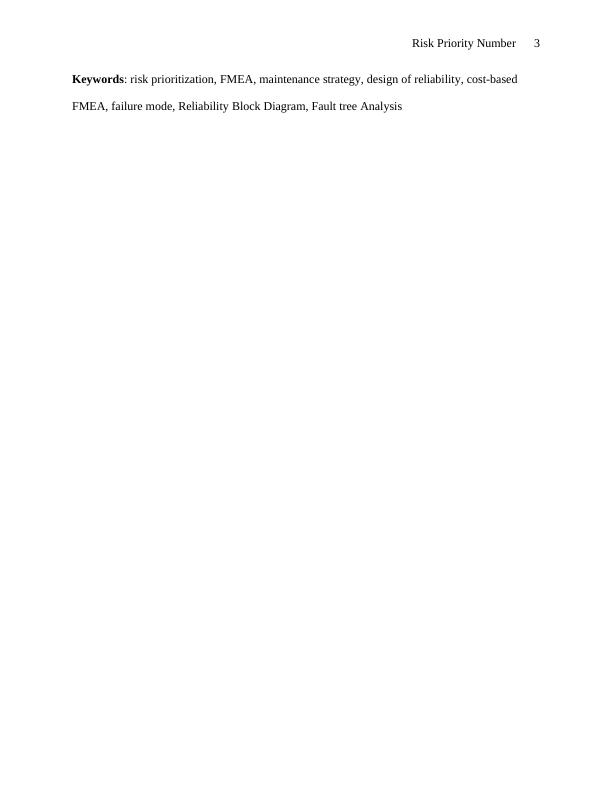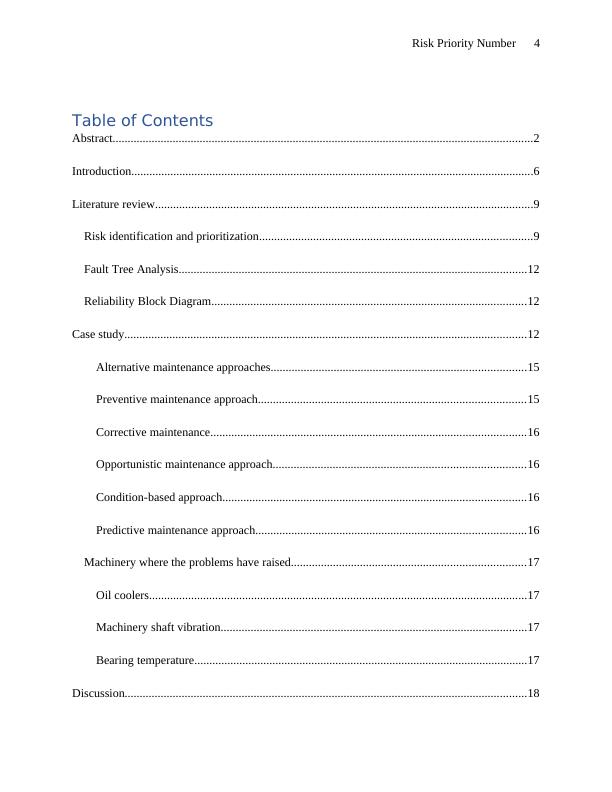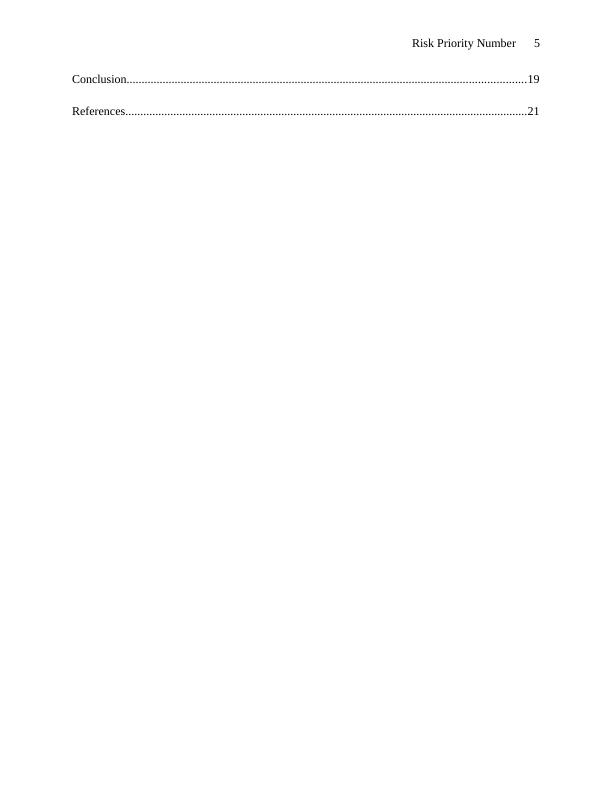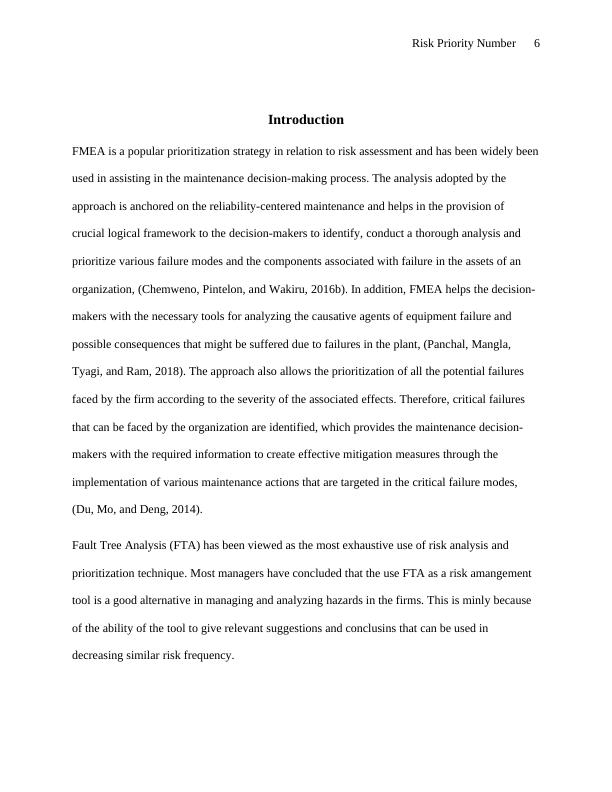Assignment on Risk Priority Number
Develop a report in the form of a journal publication based on the learning from M05 unit, focusing on design awareness in reliability and asset management through a case study.
23 Pages5038 Words22 Views
Added on 2022-08-26
Assignment on Risk Priority Number
Develop a report in the form of a journal publication based on the learning from M05 unit, focusing on design awareness in reliability and asset management through a case study.
Added on 2022-08-26
ShareRelated Documents
Risk Priority Number 1
Name of the Class
Professor
Name of the School
City and State
Date
Name of the Class
Professor
Name of the School
City and State
Date

Risk Priority Number 2
Abstract
There is numerous literature work that has documented the use of FMEA, FTA and RBD as in
the implementation of failure and risk analysis. However, most of the studies have usually
focused in analyzing one of the above strategies of risk analysis and prioritization in their
managerial methodology. On the other side, a combination of the three tools will greatly reduce
the degree of drawbacks associated with the risk analysis and prioritization. The failure mode
and effect analysis (FMEA) using the risk priority numbers (RPN) has been used vastly for
proper identification and prioritization of failure modes with the primary view of creating a
mitigation mechanism to the overall impact they will have on the equipment failure. However, in
the traditional setup, the risk prioritization strategy using the RNP is short of the objectivity that
is needed to ensure a robust risk assessment most importantly where the equipment data is
available which can be used to achieve objectivity. This study will cover extensively analyze the
combination of the three tools in a quantitative approach that is used in prioritizing failure mode
and the various failure components in a firm narrowly making the required leverages in the
equipment maintenance data available in the firm. To increase the objectivity of the prioritization
process, the adopted approach takes into account 3 main objective measures- percentage
downtime effect of the failure, the total cost of the failure and various failure occurrences and
their occurrence rate. The three measures use integrated measures are shown to be more robust
for risk prioritization unlike the ordinal indices given in the case of FMEA strategy approach.
Using the available recorded data, the study adopts a three-step ranking strategy in prioritizing
severe and critical failures in an electric power facility where a case study is analyzed to explain
the effects. This approach is largely described as intuitive, insightful and generalizable to the
maintenance practitioners of the plant.
Abstract
There is numerous literature work that has documented the use of FMEA, FTA and RBD as in
the implementation of failure and risk analysis. However, most of the studies have usually
focused in analyzing one of the above strategies of risk analysis and prioritization in their
managerial methodology. On the other side, a combination of the three tools will greatly reduce
the degree of drawbacks associated with the risk analysis and prioritization. The failure mode
and effect analysis (FMEA) using the risk priority numbers (RPN) has been used vastly for
proper identification and prioritization of failure modes with the primary view of creating a
mitigation mechanism to the overall impact they will have on the equipment failure. However, in
the traditional setup, the risk prioritization strategy using the RNP is short of the objectivity that
is needed to ensure a robust risk assessment most importantly where the equipment data is
available which can be used to achieve objectivity. This study will cover extensively analyze the
combination of the three tools in a quantitative approach that is used in prioritizing failure mode
and the various failure components in a firm narrowly making the required leverages in the
equipment maintenance data available in the firm. To increase the objectivity of the prioritization
process, the adopted approach takes into account 3 main objective measures- percentage
downtime effect of the failure, the total cost of the failure and various failure occurrences and
their occurrence rate. The three measures use integrated measures are shown to be more robust
for risk prioritization unlike the ordinal indices given in the case of FMEA strategy approach.
Using the available recorded data, the study adopts a three-step ranking strategy in prioritizing
severe and critical failures in an electric power facility where a case study is analyzed to explain
the effects. This approach is largely described as intuitive, insightful and generalizable to the
maintenance practitioners of the plant.

Risk Priority Number 3
Keywords: risk prioritization, FMEA, maintenance strategy, design of reliability, cost-based
FMEA, failure mode, Reliability Block Diagram, Fault tree Analysis
Keywords: risk prioritization, FMEA, maintenance strategy, design of reliability, cost-based
FMEA, failure mode, Reliability Block Diagram, Fault tree Analysis

Risk Priority Number 4
Table of Contents
Abstract............................................................................................................................................2
Introduction......................................................................................................................................6
Literature review..............................................................................................................................9
Risk identification and prioritization...........................................................................................9
Fault Tree Analysis....................................................................................................................12
Reliability Block Diagram.........................................................................................................12
Case study......................................................................................................................................12
Alternative maintenance approaches.....................................................................................15
Preventive maintenance approach.........................................................................................15
Corrective maintenance.........................................................................................................16
Opportunistic maintenance approach....................................................................................16
Condition-based approach.....................................................................................................16
Predictive maintenance approach..........................................................................................16
Machinery where the problems have raised..............................................................................17
Oil coolers..............................................................................................................................17
Machinery shaft vibration......................................................................................................17
Bearing temperature...............................................................................................................17
Discussion......................................................................................................................................18
Table of Contents
Abstract............................................................................................................................................2
Introduction......................................................................................................................................6
Literature review..............................................................................................................................9
Risk identification and prioritization...........................................................................................9
Fault Tree Analysis....................................................................................................................12
Reliability Block Diagram.........................................................................................................12
Case study......................................................................................................................................12
Alternative maintenance approaches.....................................................................................15
Preventive maintenance approach.........................................................................................15
Corrective maintenance.........................................................................................................16
Opportunistic maintenance approach....................................................................................16
Condition-based approach.....................................................................................................16
Predictive maintenance approach..........................................................................................16
Machinery where the problems have raised..............................................................................17
Oil coolers..............................................................................................................................17
Machinery shaft vibration......................................................................................................17
Bearing temperature...............................................................................................................17
Discussion......................................................................................................................................18

Risk Priority Number 5
Conclusion.....................................................................................................................................19
References......................................................................................................................................21
Conclusion.....................................................................................................................................19
References......................................................................................................................................21

Risk Priority Number 6
Introduction
FMEA is a popular prioritization strategy in relation to risk assessment and has been widely been
used in assisting in the maintenance decision-making process. The analysis adopted by the
approach is anchored on the reliability-centered maintenance and helps in the provision of
crucial logical framework to the decision-makers to identify, conduct a thorough analysis and
prioritize various failure modes and the components associated with failure in the assets of an
organization, (Chemweno, Pintelon, and Wakiru, 2016b). In addition, FMEA helps the decision-
makers with the necessary tools for analyzing the causative agents of equipment failure and
possible consequences that might be suffered due to failures in the plant, (Panchal, Mangla,
Tyagi, and Ram, 2018). The approach also allows the prioritization of all the potential failures
faced by the firm according to the severity of the associated effects. Therefore, critical failures
that can be faced by the organization are identified, which provides the maintenance decision-
makers with the required information to create effective mitigation measures through the
implementation of various maintenance actions that are targeted in the critical failure modes,
(Du, Mo, and Deng, 2014).
Fault Tree Analysis (FTA) has been viewed as the most exhaustive use of risk analysis and
prioritization technique. Most managers have concluded that the use FTA as a risk amangement
tool is a good alternative in managing and analyzing hazards in the firms. This is minly because
of the ability of the tool to give relevant suggestions and conclusins that can be used in
decreasing similar risk frequency.
Introduction
FMEA is a popular prioritization strategy in relation to risk assessment and has been widely been
used in assisting in the maintenance decision-making process. The analysis adopted by the
approach is anchored on the reliability-centered maintenance and helps in the provision of
crucial logical framework to the decision-makers to identify, conduct a thorough analysis and
prioritize various failure modes and the components associated with failure in the assets of an
organization, (Chemweno, Pintelon, and Wakiru, 2016b). In addition, FMEA helps the decision-
makers with the necessary tools for analyzing the causative agents of equipment failure and
possible consequences that might be suffered due to failures in the plant, (Panchal, Mangla,
Tyagi, and Ram, 2018). The approach also allows the prioritization of all the potential failures
faced by the firm according to the severity of the associated effects. Therefore, critical failures
that can be faced by the organization are identified, which provides the maintenance decision-
makers with the required information to create effective mitigation measures through the
implementation of various maintenance actions that are targeted in the critical failure modes,
(Du, Mo, and Deng, 2014).
Fault Tree Analysis (FTA) has been viewed as the most exhaustive use of risk analysis and
prioritization technique. Most managers have concluded that the use FTA as a risk amangement
tool is a good alternative in managing and analyzing hazards in the firms. This is minly because
of the ability of the tool to give relevant suggestions and conclusins that can be used in
decreasing similar risk frequency.

End of preview
Want to access all the pages? Upload your documents or become a member.
Related Documents
Reliability Analysislg...
|8
|947
|61
The program thus focusses on the systemlg...
|7
|3308
|17
Types of Engineering Strategies in Rail Engineering Equipmentlg...
|21
|4179
|259
Safety Shutdown System for Oil Storage Tank - Deskliblg...
|7
|1711
|246
Risk Assessment Report for Cloud-Centumlg...
|13
|3442
|497
Risk and Risk Management Conceptslg...
|105
|27941
|54
